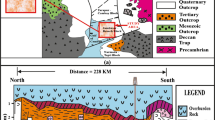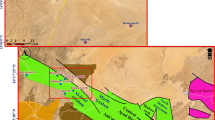Abstract
The Cambay Basin, on the western continental margin of India, is infilled with transgressive Paleocene to early Eocene Cambay Shale Formation. Cores, electrolog data and correlations, and geochemical data allow organofacies characterization of the formation in the Jambusar–Broach area. Eleven transgressive–regressive sequences have been identified within the formation based on electrolog characteristics. Sedimentological analysis indicates that the bottom fining-upward part of these sequences is rich in organic matter. Geochemical data of these sequences of the formation is evaluated in terms of total organic carbon (TOC), source potential (S1 and S2) and thermal maturity index (Tmax). This clearly shows that the formation is a potential source rock for oil/gas generation, mostly with type III and minor contribution of type II organic matter. Vitrinite reflectance (VRo) data suggest that the formation is in the early to late oil generation window. However, an extrapolated trend of VRo vs. depth shows that the formation is falling within a gas window in the deeper part. The geochemical model based on the computed parameters (TOC, HI, source thickness and kinetics) is integrated with the available geological model of the study area. Then, 3D petroleum system modeling is carried out for evaluation of the source potential of the Cambay Shale Formation. Finally, play chance mapping (PCM) is attempted to identify sweet spots. Thus, the overall approach assists in the exploration of unconventional plays in the area.
















Source rock maturity overlay of TRS-I shows a maturity ranging from immature to dry gas (0 to >2 Ro%). Mainly N–S central part of the Broach depression is confined by the gas window (>1.3 Ro%).



Similar content being viewed by others
References
Aswal H S, Murthy M S, Singh J and Nayak K K 2009 Determination of span of major hiatuses in southern part of Cambay Basin, based on micropaleontological and Palynological evidences; Explotech 4 123–143.
Aswal H S, Thakkar T I, Topno M, Grover R, Panda B B, Borthakur J and Parthimon P T 2015 Detailed Litho-biostratigraphic and depositional environmental studies of well drilled for shale gas/oil exploration in Cambay basin; ONGC Unpubl. Rep. 65–83.
Banerjee A, Pahari S, Jha M, Sinha A K, Jain A K, Kumar N, Thomas N J, Misra K N and Chandra K 2002 The effective source rocks in the Cambay basin, India; AAPG Bull. 86 433–456.
Bhattacharya B and Banerjee P P 2015 Record of Permian Tethyan transgression in eastern India: A reappraisal of the Barren Measures Formation, West Bokaro Coalfield; Mar. Petrol. Geol. 67 170–179.
Bhattacharya B, Bhattacharjee J, Banerjee S, Roy T and Banerjee S 2021 Palaeogeographic implications of ichnotaxa assemblages from early Permian fluvio-marine Barakar Formation, Raniganj Basin, India; J. Earth Syst. Sci. 130 12.
Bhattacharya B, Banerjee P P and Roy P 2022 Implications of marine Gastropoda Baylea DeKoninck, 1883 from the Permian Barren Measures Formation, Lower Gondwana, West Bokaro Basin, eastern India; J. Earth Syst. Sci. 131 208.
Biswas S K 1982 Rift Basins in western margin of India and their hydrocarbon prospects with special reference to Kutch Basin; AAPG Bull. 66 1497–1513.
Biswas S K 1987 Regional tectonic structure and evolution of the Western margin basins of India; Tectonophys. 135 307–327.
Chen L, Jiang Z, Liu K, Wang P, Ji W, Gao F and Huang H 2016 Effect of lithofacies on gas storage capacity of marine and continental shales in the Sichuan Basin, China; J. Nat. Gas Sci. Eng. 36 773–785.
Clarkson C R, Solano N, Bustin R M, Bustin A M M, Chalmers G R L, He L and Blach T P 2013 Pore structure characterization of North American shale gas reservoirs using USANS/SANS, gas adsorption, and mercury intrusion; Fuel 103 606–616.
Dahl J, Moldown J M, Walls J, Nur A and De Vito J 2012 Creation of porosity in tight shales during organic matter maturation; AAPG Searc. Discov. 40979.
Hammes U and Frébourg G 2012 Haynesville and Bossier mudrocks: A facies and sequence stratigraphic investigation, East Texas and Louisiana, USA; Mar. Pet. Geol. 31(1) 8–26.
Jaiswal S and Bhattacharya B 2018 Characterization of middle Eocene tide-influenced delta: A study from core samples of Hazad Member, Ankleshwar Formation, South Cambay Basin, India; J. Earth Syst. Sci. 127 123–130.
Jaiswal S, Bhattacharya B and Chakrabarty S 2018 High resolution sequence stratigraphy of Middle Eocene Hazad Member, Jambusar-Broach Block, Cambay Basin, India; Mar. Petrol. Geol. 93 79–94.
Jarvie D M and Baker D R 1984 Application of the Rock Eval III oil show analyser to the study of gaseous hydrocarbons in an Oklahoma gas well; 187th ACS Nat. Meet., St. Louis, Missouri.
Jarvie D M, Ronald J H, Ruble T E, Pollastro M R and Richard M 2007 Unconventional Shale-gas systems: The Mississippian Barnett Shale of north-central Texas as one model for thermogenic shale-gas assessment; AAPG Bull. 91 475–499.
Kumar A, Padhy P K and Das S K 2013 Shale gas: Indian scenario and ONGC perspective; ONGC Bull. 48(5) 133–154.
Kundu J, Wani M R and Thakur R K 1993 Structural styles in South Cambay Rift Basin and its control on post rift deltaic sedimentation; In: Proc. 2nd Seminar on Petroliferous Basins of India (eds) Biswas S K et al., Indian Petroleum Pub., Dehradun 2 79–96.
Kundu J, Kar S, Prakash A and Parsad B 1996 Basement configuration and distribution of depocentres of Cambay Basin; Unpubl. Rep. ONGC, Dehradun.
Landis C R and Castano R 1995 Maturation and bulk chemical properties of a suite of solid hydrocarbons; Org. Geochem. 22 137–149.
Loucks R G, Reed R M, Ruppel S C and Hammes U 2012 Spectrum of pore types and networks in mudrocks and a descriptive classification for matrix-related mudrock pores; AAPG Bull. 96(6) 1071–1098.
Madan M 1995 Cambay Basin: A promise of oil and gas potential; J. Palaeontol. Soc. India 40 41–47.
Mangotra S R 1993 Kinetic modelling of kerogen of Cambay Basin; An unpublished report ONGC Ltd.
Mehrotra R B and Ramakrishna V 1980 A relook in the stratigraphy and hydrocarbon occurrences of North Cambay Basin with special reference to Kadi Formation; Unpubl. Rep. ONGC.
Mehrotra R B and Ramkrishna V 1981 Stratigraphy of Cambay Basin at a glance; Unpubl. ONGC Rep.
Nortan I O and Sclater J G 1979 A model for the evolution of the Indian Ocean breakup of Gondwanaland; J. Geophys. Res. 84(B12) 6803–6830.
Padhy P K and Das S K 2013 Shale oil and Gas Plays: Indian sedimentary Basins; Geohorizons 18 20–25.
Pandey J, Singh N P, Krishna B R, Sharma D D, Parakh A K and Nath S S 1993 Lithostratigraphy of Indian Petroliferous basins: Document – III, Cambay Basin; KDMIPE, ONGC, Dehradun.
Parakh A K, Sahu S K, Prakash A, Negi A, Pillai S, Aswal H S, Srivastava S and Niranjan N 2007 Sequence stratigraphy frame work, Cambay Basin Interim Report; Unpubl. Rep. ONGC.
Passey Q R, Bohacs K M, Esch W L, Klimentidis R and Sinha S 2010 From oil-prone source rocks to gas producing shale reservoir-geologic and petrophysical characterization of unconventional shale-gas reservoirs; SPE 131350 29.
Peters K E and Nelson P H 2009 Criteria to determine borehole formation temperature calibration of basin and petroleum system models; Searc. Discov. 40463.
Peters K E, Xia X, Pomerantz A E and Mullins O C 2016 Geochemistry applied to evaluation of unconventional resources; In: Unconventional Oil and Gas Resources Handbook (eds) Ma Z and Holditch S, Elsevier Inc., Chapter 3, pp. 71–126.
Phaye D K, Bhattacharya B and Chakrabarty S 2021 Heterogeneity characterization from sequence stratigraphic analysis of Paleocene-Early Eocene Cambay Shale Formation in Jambusar-Broach area, Cambay Basin, India; Mar. Petrol. Geol. 128 104986.
Sinha A K, Das S K, Jha S K and Chandra Y 2018 Shale-oil Resource System in Cambay basin, India; ONGC Bull. 53 163–180.
Slatt R M and Rodriguez N D 2012 Comparative sequence stratigraphy and organic geochemistry of gas shales: Commonality or coincidence?; J. Nat. Gas. Sci. Eng. 8 64–68.
Sweeney J J and Burnham A K 1990 Evaluation of a simple model of vitrinite reflectance based on chemical kinetics; AAPG Bull. 74 1559–1570.
Tang X, Jiang Z, Jiang S, Cheng L and Zhang Y 2017 Characteristics and origin of in situ gas desorption of the Cambrian Shuijingtuo formation shale gas reservoir in the Sichuan Basin, China; Fuel 187 285–295.
Varshney H and Bhattacharya B 2023 Implications of Late Palaeozoic postglacial marine transgressive-regressive (T-R) cycles recorded in the Talchir Formation, Son Valley Basin, peninsular India: A sequence stratigraphic paradigm; Geol. J. 58(1) 333–355.
Vinci Technologies 1996 Rock Eval-6 User Guide, Rueil-Malmaison Cedex, France.
Zhao J, Jin Z, Jin Z, Wen X, Geng Y, Yan C and Nie H 2016 Lithofacies and sedimentary environment of shale in Wufeng–Longmaxi Formation, Sichuan Basin; Acta Pet. Sin. 37 572–586.
Zou C 2012 Unconventional Petroleum Geology; Elsevier Science, United States, 164p.
Zou C N, Dong D Z, Wang Y, Li X, Huang J, Wang S and Bai W 2015 Shale gas in China Characteristics, challenges and prospects (I); Pet. Explor. Dev. 42(6) 689–701.
Acknowledgements
The authors are immensely grateful to Shri R K Srivastava, Director (Exploration), ONGC, for giving permission to publish this paper. The authors are indebted to Shri Shrikant N Chitnis, ED-HoI, KDMIPE, ONGC, for constant encouragement and extending the support and facilities at ONGC. The authors are grateful to the Associate Editor and the anonymous reviewers for constructive suggestions. The help rendered by functionaries of Geology and Geochemistry Divisions, KDMIPE, ONGC and COD-Shale, Vadodara, ONGC is also acknowledged. The views expressed in this paper reflect the interpretation of the authors and may not necessarily represent the formal position of ONGC.
Author information
Authors and Affiliations
Contributions
Dhanesh Kumar Phaye: Conceptualization, methodology, software, investigation, visualization, original draft writing, reviewing and editing. Biplab Bhattacharya: Supervision, conceptualization, visualization, writing – reviewing and editing.
Corresponding author
Additional information
Communicated by Joydip Mukhopadhyay
Rights and permissions
About this article
Cite this article
Phaye, D.K., Bhattacharya, B. Organofacies and source evaluation of Cambay Shale Formation to assess unconventional hydrocarbon potential in Jambusar–Broach area, Cambay Basin, India. J Earth Syst Sci 132, 155 (2023). https://doi.org/10.1007/s12040-023-02161-7
Received:
Revised:
Accepted:
Published:
DOI: https://doi.org/10.1007/s12040-023-02161-7




